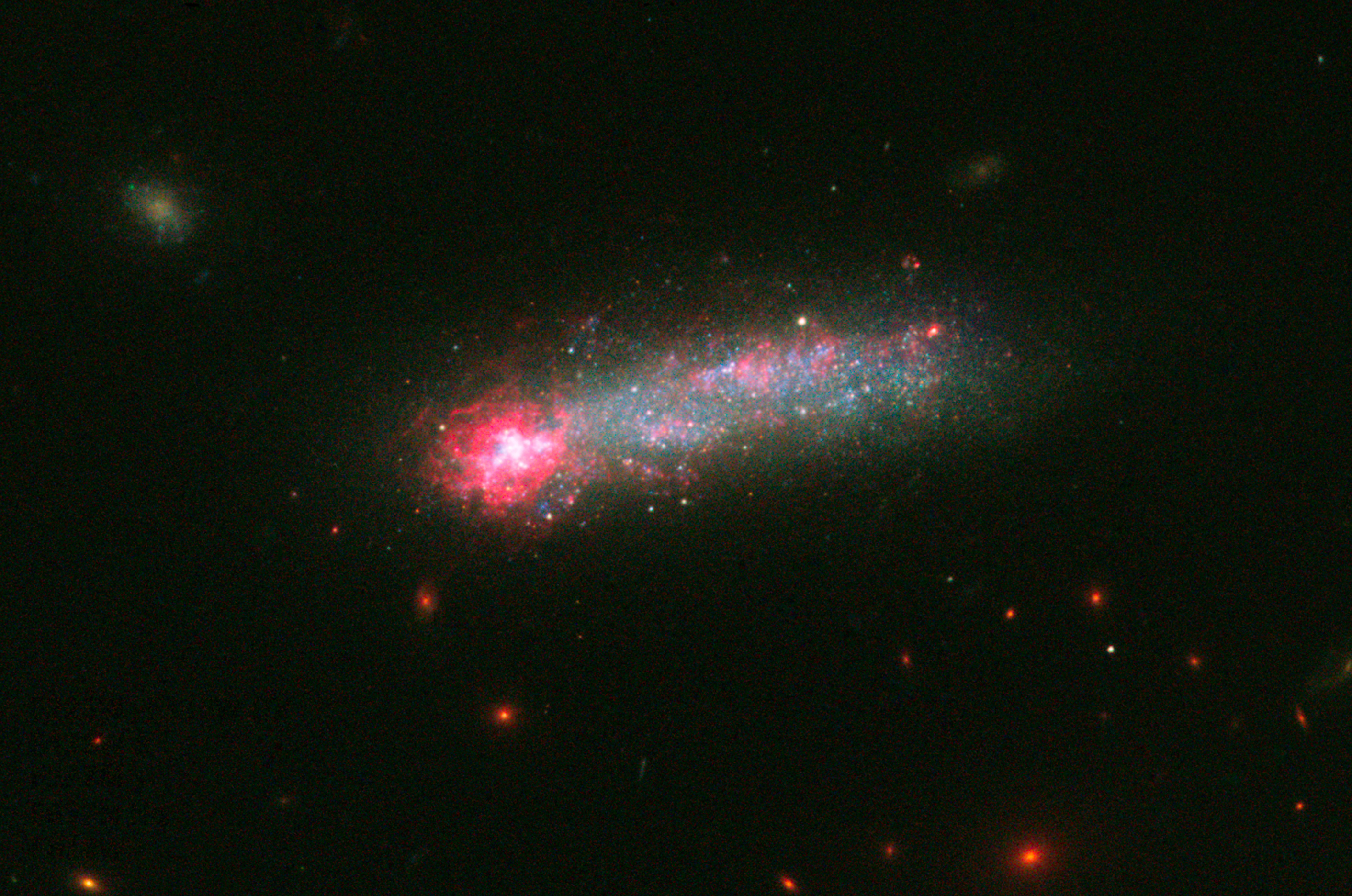Fireworks are happening in space, according to NASA’s Hubble Space Telescope that has captured images of a magnificent display in small, nearby galaxy that looks like a colorful skyrocket.
A firestorm of star birth is setting one end of the tiny galaxy Kiso 5639 aglow. The diminutive galaxy is shaped like a flattened disc, but because it is tilted head-first, it resembles a rocket on its way down, with a brilliantly blazing head and a long, sparkly tail.
Kiso 5639 is a unique, nearby example of elongated galaxies that happen frequently at farther distances, where scientists observe the universe during its earlier centuries. Astronomers suggest that the multiple star births responsible for the fireworks is due to intergalactic gas accumulating on one end of the galaxy as it drifts through space, NASA reports.
Debra Elmegreen, lead researcher from Vassar College in Poughkeepsie, New York, said,
I think Kiso 5639 is a beautiful, up-close example of what must have been common long ago.
She adds, “The current thinking is that galaxies in the early universe grow from accretion of gas from the surrounding neighborhood. It’s a stage that galaxies, including our Milky Way, must go through as they are growing up.”
Observations of the universe in its early epochs, such as Hubble’s Ultra Deep Field, have found that around 10% of all galaxies have these elongated shapes, collectively called “tadpoles.” But studies of the universe near Earth have only shown a few of these unique galaxies, including Kiso 5639. The development of these nearby elongated galaxies is beyond those like them, which have spent billions of years building and transforming into what can be seen as spiral galaxies.
Elmegreen used Hubble’s Wide Field Planetary Camera 3 to do an intensive imaging study of the small Kiso 5639. With this, the images appear in different filters, revealing information by dissecting an object’s light into component colors. The crisp resolution from the Hubble Camera helped Elmegreen and her colleagues better analyze the giant star births in Kiso 5639 and determine the masses and ages of these star clusters.
The international team of scientists chose Kiso 5639 from a survey of 10 nearby tadpole galaxies, observed using the Grand Canary Telescope in La Palma, Spain. J. Sanchez Almeida and a team at the Instituto de Astrofisica de Canarias found that most of the galaxies, Kiso 5639 included, did not have uniform gas compositions.
The bright gas collected in the galaxy’s head contains fewer heavy elements, or metals, such as carbon and oxygen, than the rest of the tail. Stars are mostly composed of hydrogen and helium, but can make other heavier elements. When stars die, they release the heavy elements and add it to the surrounding gases.
“The metallicity suggests that there has to be rather pure gas, composed mostly of hydrogen, coming into the star-forming part of the galaxy, because intergalactic space contains more pristine hydrogen-rich gas,” Elmegreen said. “Otherwise, the starburst region should be as rich in heavy elements as the rest of the galaxy.”
Hubble provides a detailed view of the galaxy’s star-making activity. The telescope discovered several dozens of star clusters in Kiso 5639’s head, which measures 2,700 light-years across. The star clusters have an average age of less than 1 million years and have masses that are three to six times larger than the stars in the rest of the galaxy. Other star births are happening elsewhere in the galaxy, but on smaller scales. Star clusters in the tail end of the galaxy are between several million to a few billion years old.
Bruce Elmegreen of IBM’s Thomas J. Watson Research Center in New York, a member of the team, said,
There is much more star formation going on in the head than what you would expect in such a tiny galaxy. And we think the star formation is triggered by the ongoing accretion of metal-poor gas onto a part of an otherwise quiescent dwarf galaxy.
The Hubble telescope also uncovered giant holes throughout the galaxy’s head, giving it a Swiss-cheese resemblance because of supernova explosions – appearing like firework aerial bursts – have carved out holes of a rare superheated gas.
Based on simulations by Daniel Ceverino of the Center for Astronomy at Heidelberg University in Germany and other members of the team, the team discovered that less than a million years ago, Kiso 5639’s leading edge came into contact with a filament of gas. This filament dropped a large mass of matter into the galaxy, setting into motion the frenzy of star births.
Debra Elmegreen expects that other parts of the galaxy might join in the fireworks-making star formations in the future, explaining that since galaxies rotate, Kiso 5639 might come into contact with another filament, sparking off another round of these star births.
The study was published in The Astrophysical Journal.
























